The AMD Trinity Review (A10-4600M): A New Hope
by Jarred Walton on May 15, 2012 12:00 AM ESTAMD Trinity Gaming Performance
After the 3DMark results, you might be wondering if Intel has finally caught up to AMD in terms of integrated graphics performance. The answer is…yes and no. Depending on the game, there are times where a fast Ivy Bridge CPU with HD 4000 will actually beat out Trinity; there are also times where Intel’s IGP really struggles to keep pace. The good news is that at least everyone is now onboard the DX11 bandwagon, and compatibility with games has improved yet again for Intel. Here are our “Value” benchmark results for seven recent games; we’ll have more information in a moment.

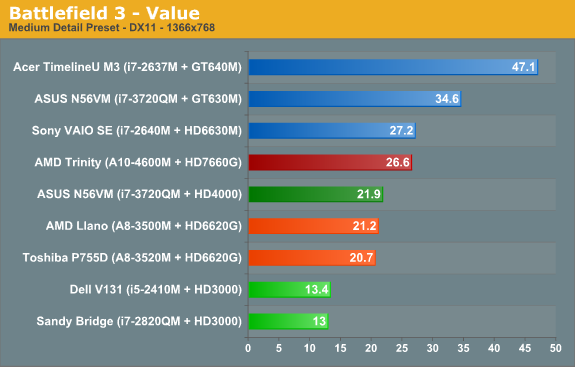
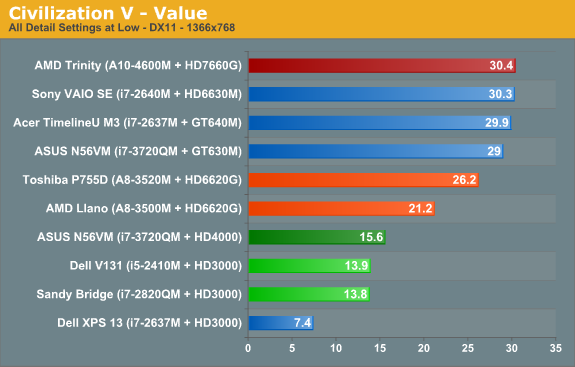

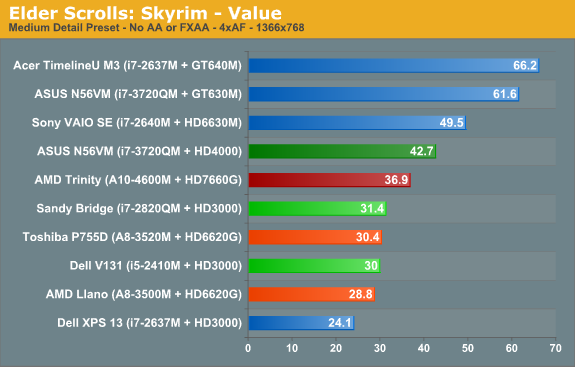
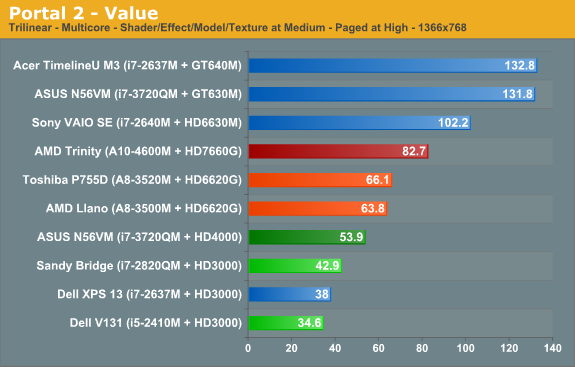
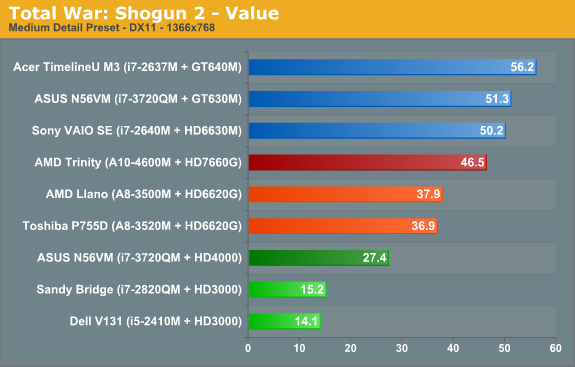
Out of our seven test titles, AMD’s Trinity leads any other IGP in four titles by a large margin. The other three titles actually have Ivy Bridge slightly ahead of Trinity, but the gaps aren’t nearly as big. Overall, the average performance across the seven games at our Value (medium) settings has AMD’s Trinity A10-4600M leading Intel’s i7-3720QM by 21%, and if we look at quad-core Sandy Bridge with HD 3000 (i7-2820QM) Trinity is 72% faster. Trinity is also around 20% faster than 35W Llano on average.
Let’s expand our gaming suite just a bit to see if things change, though. Just like we did with Ivy Bridge, we ran the eight games in our previous benchmark suite at medium detail settings. We can then compare performance across a wider 15 title selection to see how Trinity matches up against HD 4000, HD 3000, and HD 6620G (Llano). We’ll start with the bottom (HD 3000/Sandy Bridge) and move up.
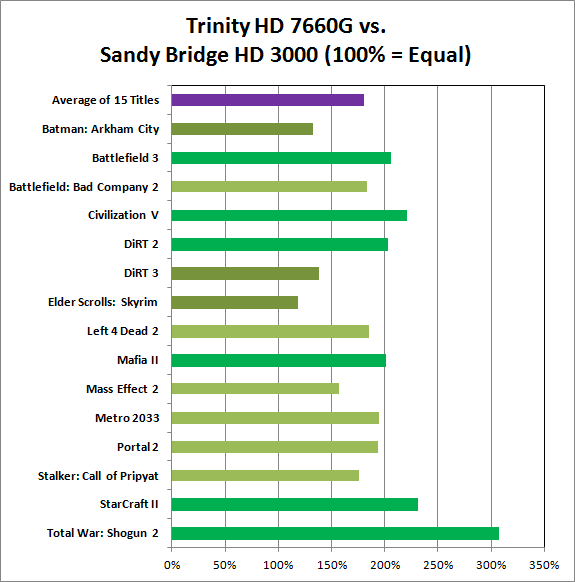
Llano’s HD 6620G was already faster than HD 3000, and Trinity’s HD 7660G is faster than Llano, so the Sandy Bridge gaming matchup is a landslide victory in AMD’s favor. The closest Intel can get is in the same three titles where Ivy Bridge leads Trinity: Batman: Arkham City, DiRT 3, and Skyrim. Here, however, HD 3000 can’t actually close the gap and HD 6620G is at least 20% faster than HD 3000, with an average performance improvement of nearly 80%.
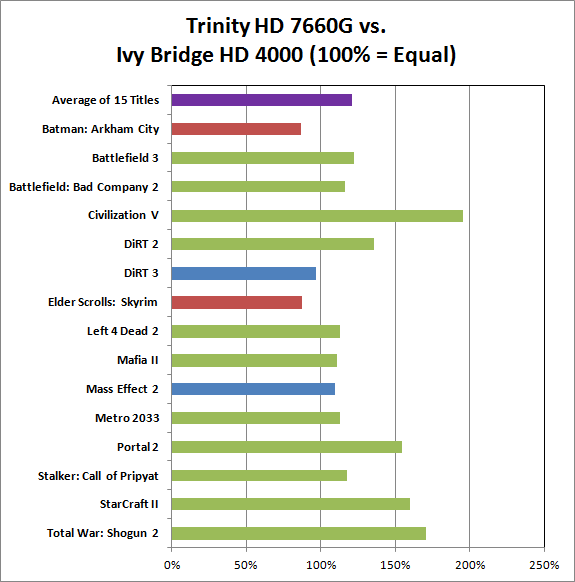
We found that across the same selection of 15 titles, Ivy Bridge and Llano actually ended up “tied”—Intel led in some games, AMD in others, but on average the two IGPs offered similar performance. This chart and the next chart will thus show a similar average increase in performance for Trinity, but the details in specific games are going to be different. Starting with Ivy Bridge and HD 4000, as with our earlier game charts we see there are some titles where Intel leads (Batman and Skyrim), a couple ties (DiRT 3 and Mass Effect 2), and the remainder of the games are faster on Trinity. Mafia II is close to our <10% “tie” range but comes in just above that mark, as do Left 4 Dead 2 and Metro 2033. The biggest gap is Civilization V, where Intel’s various IGPs have never managed good performance; Trinity is nearly twice as fast as Ivy Bridge in that title. Overall, it's a 20% lead for Trinity vs. quad-core Ivy Bridge.
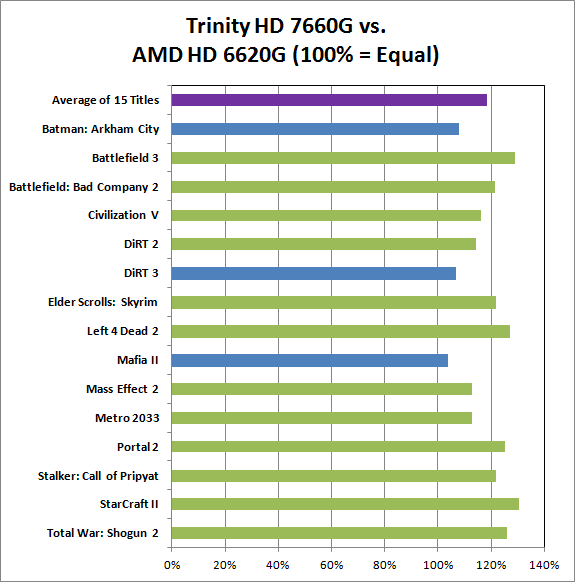
Against Llano, Trinity is universally faster, but the smallest gap is in Mafia II (3%) while the largest gap is in StarCraft II (30%). On average, looking at these games Trinity is only 18% faster than Llano. What’s not entirely clear from the above chart is whether we’re hitting CPU limitations, memory bandwidth limitations (remember that Llano and Trinity share bandwidth with the rest of the system), or perhaps both. At our chosen settings, what is clear is that Trinity’s “up to 56% faster” graphics never make it that high.
We saw 35-45% higher scores in 3DMark 11 and Vantage, which tend to remove the CPU from the equation more than actual games, so our guess would be that if AMD continues with their APU plan they’re going to need to work more on the CPU side of the equation. We also see the same thing looking at the VAIO SE scores in the earlier gaming charts: the HD 6630M scores are 20% faster on average, but much of that appears to come from the faster CPU rather than the GPU.










271 Comments
View All Comments
deathpony - Tuesday, May 15, 2012 - link
Also the Gpu overclock wasn't limited by the chip itself but by a bios limitation, by staying at stock voltage i could have reached 2.5 Ghz realistically. But with such high clocks i think the Gpu was starved by the main memory bandwidth.Rookierookie - Tuesday, May 15, 2012 - link
Let's not forget though, A New Hope came BEFORE The Empire Strikes Back...JarredWalton - Tuesday, May 15, 2012 - link
But it also came after the Phantom Menace, Attack of the Clones, and Revenge of the Sith. *Shudder* Thanks for making me remember baby Anakin and Jar Jar, you cruel, cruel person.... ;-)wintermute000 - Tuesday, May 15, 2012 - link
looks like a nice well rounded product for the budget to mid range.the CPU is fine for 'normal' workloads, and the IGP can handle AAA titles @ medium detail 720p.
Agreed the devil is in the pricing, it needs to be substantially cheaper than i5+optimus otherwise theres no point.
phatboye - Tuesday, May 15, 2012 - link
When referring to AMD Bulldozer based architectures please use the term "module" instead of "core" as it gets confusing as to which one you are talking about.JarredWalton - Tuesday, May 15, 2012 - link
If you know enough to post this comment, you should also know enough to understand from context whether we're talking about a Piledriver core (e.g. the INT core) or a Piledriver module (e.g. two INT cores and the shared FP). And trust me, it's just as confusing trying to write about Bulldozer architectures as it is to read about them. But if there's a specific place in the article where we say "core" when we should say "module", let me know where and I'll be happy to correct it.phatboye - Tuesday, May 15, 2012 - link
Actually I was confused at first. On the first page you stated that the A10 chip was a 4 core chip. Before reading this article I was under the impression that the first trinity chips would have 8 cores (4 modules). It took a bit of reading before I realized that what you said was actually correct in that in that it is a 4 core (2 module) CPU.Yes the misunderstanding was totally my fault but it would make things a lot easier if you made a convention when referring to AMD bulldozer "cores" in terms of modules instead.
Cow86 - Tuesday, May 15, 2012 - link
You seem to have forgotten to mention the 'resonant clock mesh' technology that AMD recently acquired, and uses in Piledriver (and therefore Trinity)...said to account for a ~10% saving in power consumption at the same clockspeed alone already.Anyway, I'm rather pleased to see this part arrive :) Seems to put AMD in a much better position in the mobile space again, and I'd be very interested to see how they can compete with ultrabooks this time around with their 17W chips. Now to wait how they measure up on the desktop as well...And of course the new FX CPU's later this year...bodes well for those too, looking at the reduced power consumption, as their high power draw is the biggest problem right now.
mikato - Wednesday, May 16, 2012 - link
Yeah nice catch. I forgot that was going in Trinity.ltcommanderdata - Tuesday, May 15, 2012 - link
In one of the AMD slides on the first page, it mentions Trinity supports AVX1.1. I haven't heard of that standard before, only AVX and AVX2. What does AVX1.1 add over AVX and is AMD the only one to implement it right now?I also saw you tried WinZip 16.5 OpenCL and Ivy Bridge OpenCL which I commented on before. Thanks for that. Too bad the results didn't turn out that exciting.